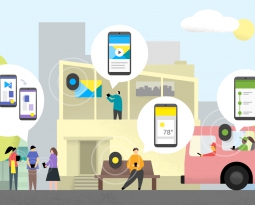You may have heard about the internet of things (IoT) or even dipped your toes into its functionality, but the Physical Web project will soon turn everything you thought you knew about the IoT on its ear.
Learn more about what the project means and why we are ecstatic to be on board of the revolution by reading on.
What Is the Physical Web?
The Physical Web is an open source project headed by Google but powered through collaboration. It intends to connect IoT devices with one another as well as with computer platforms like smartphones and laptops. When IoT products are made Physical Web compliant, users can enjoy intuitive functionality and new levels of interactivity.
Behind the idea is a desire to eliminate the layers of complexity developers and end-users butt up against when trying to access IoT functionality. The problem with the IoT right now is that while there are plenty of smart gadgets out there like the Nest thermostat, beacons and connected cars, interacting with all of them can be a bit touch and go. Each product usually must have its own app for users to get the most functionality.
For instance, someone who wants to know if their Nest is running when they are not at home will likely have to open a special app to do so. They will have to use another app if they want to start their car and turn on the heater before they enter the parking lot. Some solutions intend to combine app functions within a more comprehensive API, but every device must usually be added and configured one at a time.
Instead of asking everyone to create, download and use separate apps for each IoT-enabled product, the Physical Web intends to bridge all of the communication gaps with simple URL addresses. Products like Eddystone’s beacon programming language are already realizing this potential by sending out page URLs instead of app-specific data. That way, someone visiting a beacon-equipped retail store can receive a simple browser link to learn more about a product or receive a special offer rather than having to have a proprietary app.
What Can the Physical Web Do?
The most important use of the Physical Web is that it can create direct technological solutions for when someone wants a piece of information. As an example, a beacon in front of a restaurant can deliver a menu to a smartphone user that has never heard of the restaurant when they stop and look in the window. In effect, walking by the beacon is like pushing a “Find Out More” button with the link conveniently delivered to your phone.
This level of functionality has caused some like PostScapes’ Ted Burnham to describe the Physical Web as a way “to present users with a search engine for the world around them.” Beacons are the cheapest way to get this capability since they cost only around $8–$15 apiece, but smart objects themselves can also communicate through the physical web.
While we could come up with some illustrative uses of the Physical Web on our own, Google has done a great job on their github project description page:
- A bus can tell you its next stop
- A parking meter can let you pay using your phone and the cloud
- Industrial equipment can offer diagnostics
- Any store, no matter how small, can offer an online experience when you walk in
- A cat collar can let you call to find the owner
- A shared car service can broadcast a signup page, allowing you to immediately drive away
How Businesses Can Get Onboard
While the Physical Web source code is freely available online, third-party solutions incorporating Physical Web capability are likely going to be a cheaper, more agile option for most businesses. Social Retail’s convergence platform, for instance, has been updated to incorporate Physical Web functionality. Continued updates will beef up its abilities to interact with more IoT devices and add new features to them.
Become a part of the leading edge of technology and enhance your brand’s ability to stay connected with its customers using our product. Click here to discover more about what Social Retail can do for your business using the Physical Web.






